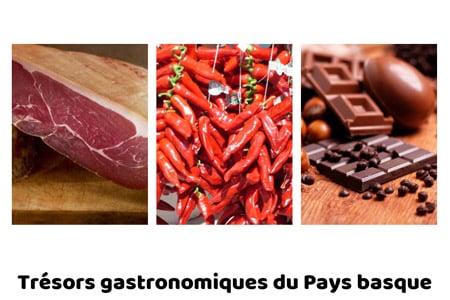The Basque Country is famous for its gastronomy and art of living. Here are three unmissable Basque culinary specialities that have the whole world salivating!

Piment d’Espelette, red, brilliant, sweet and powerful at the same time
This small pepper, originally from Mexico, arrived in Europe via Spain in the 16th century, and has become a veritable emblem of Basque gastronomy. Originally, it was used to season chocolate! It was later replaced by honey and cane sugar. If the small village of Espelette is the guarantor of the tradition, the famous red pepper is cooked to all sauces in all the villages of the
Basque Country
Béarn and Navarre. Since 2000, piment d’Espelette has benefited from a Protected Designation of Origin (PDO). From August to early December, chillies invade the ceilings, balconies and facades of houses to be dried before being ground into powder.
Just 30 minutes from the Lou P’tit Poun campsite, don’t miss the Chilli Festival, held at the end of October in the streets of the village of the same name. It’s an opportunity to pack your bags with Espelette chilli powder, sausage, chocolate or jam.
Chocolate, the black gold of the Basque Country
It wasn’t until 1528 that Cortes, the conqueror of Mexico, imported cocoa beans from the New World toEurope. First in Spain, then in the Basque Country. Portuguese Jewish exiles fleeing the Inquisition were the first to settle in
Bayonne
around 1610 to set up chocolate manufacturing, processing and trading establishments. It was the infanta Maria Theresa of Spain who, on marrying Louis XIV in Saint-Jean-de-Luz (1660), introduced chocolate to the French court. From then on, Bayonne became the chocolate capital of the kingdom.
To discover all the secrets of chocolate making, you’ll have to push open the doors of the
Bayonne Chocolate Museum
. Discover a fascinating journey of discovery around the theme of chocolate, with tasting at the end! Also worth a visit :
the Txokola workshop-boutique
. Behind the glass windows, watch the master chocolatiers at work and the various stages in the production of Bayonne‘s “black gold”.
Bayonne Ham, the pride of Basque pork butchers
Renowned since the Middle Ages, Bayonne Ham is the flagship of Basque hams. Marguerite de Navarre, Rabelais and Henri IV all loved it in their time. This legendary ham, the envy of the world, is made from the top of the pig’s thigh. The piece of pork is rubbed with salt from the Adour Basin, then hung in a salt cellar for 7 months to dry. During these long months of maturing, the
Bayonne Ham
develops a distinctive aroma (with a hint of hazelnut), a characteristic pinkish-red color and an inimitable softness.
During your camping vacation
in the Basque Country and southern Landes
don’t miss the annual Foire au Jambon (Ham Fair), which takes place in Bayonne over the Easter weekend, on the carreau des Halles and the Esplanade Roland-Barthes marquee. A 500-year-old tradition that attracts over 200,000 visitors over four days of festivities.
